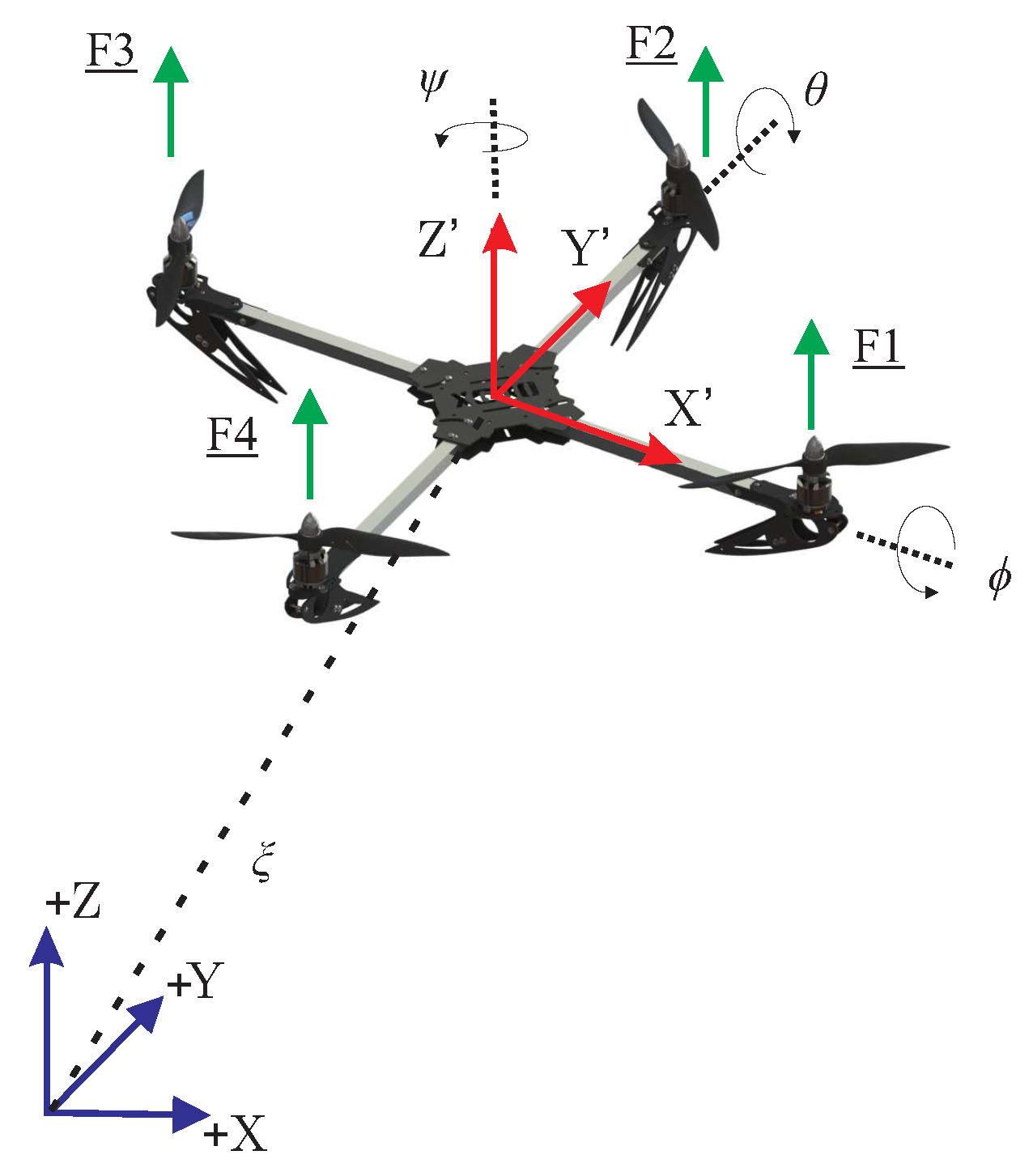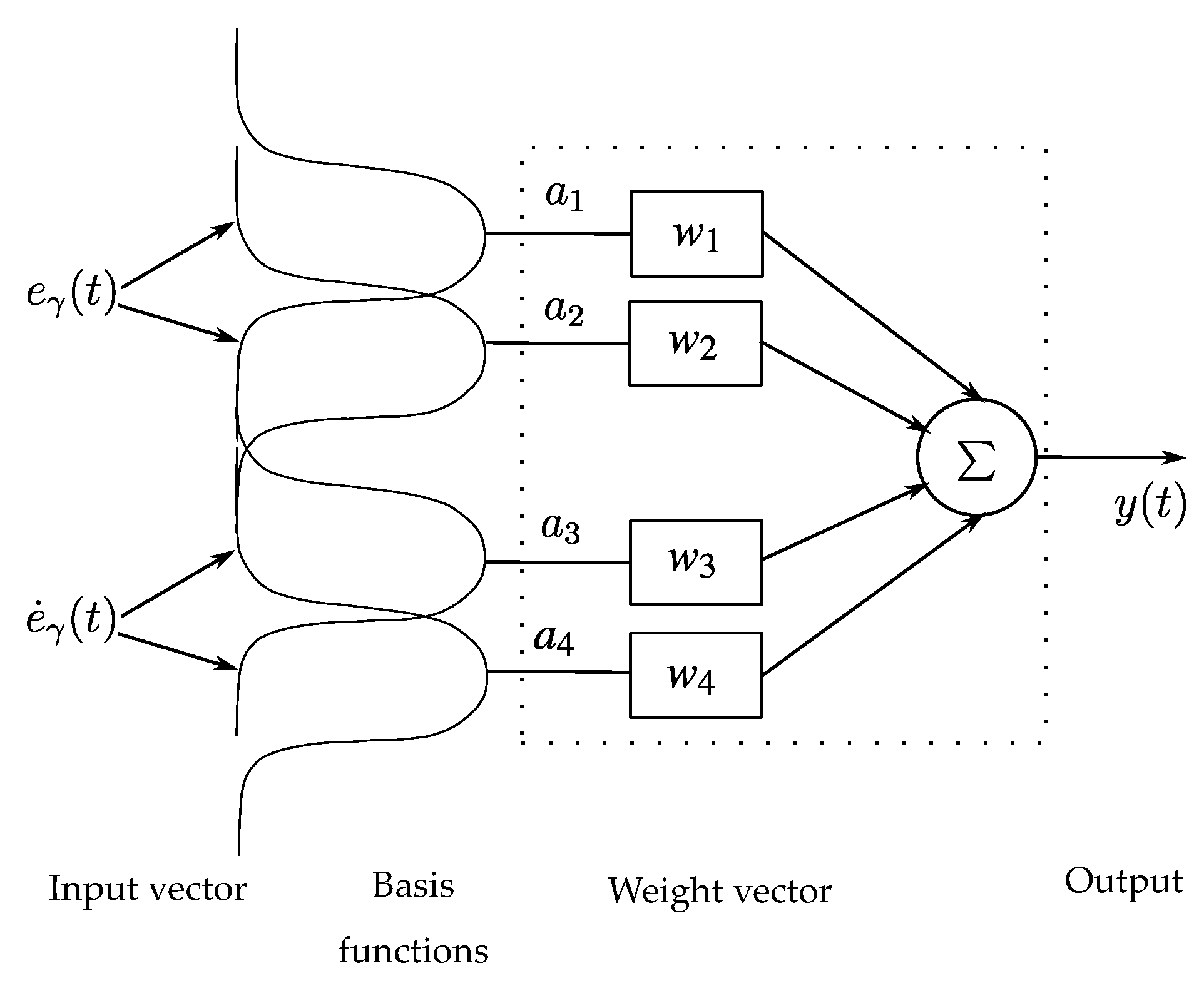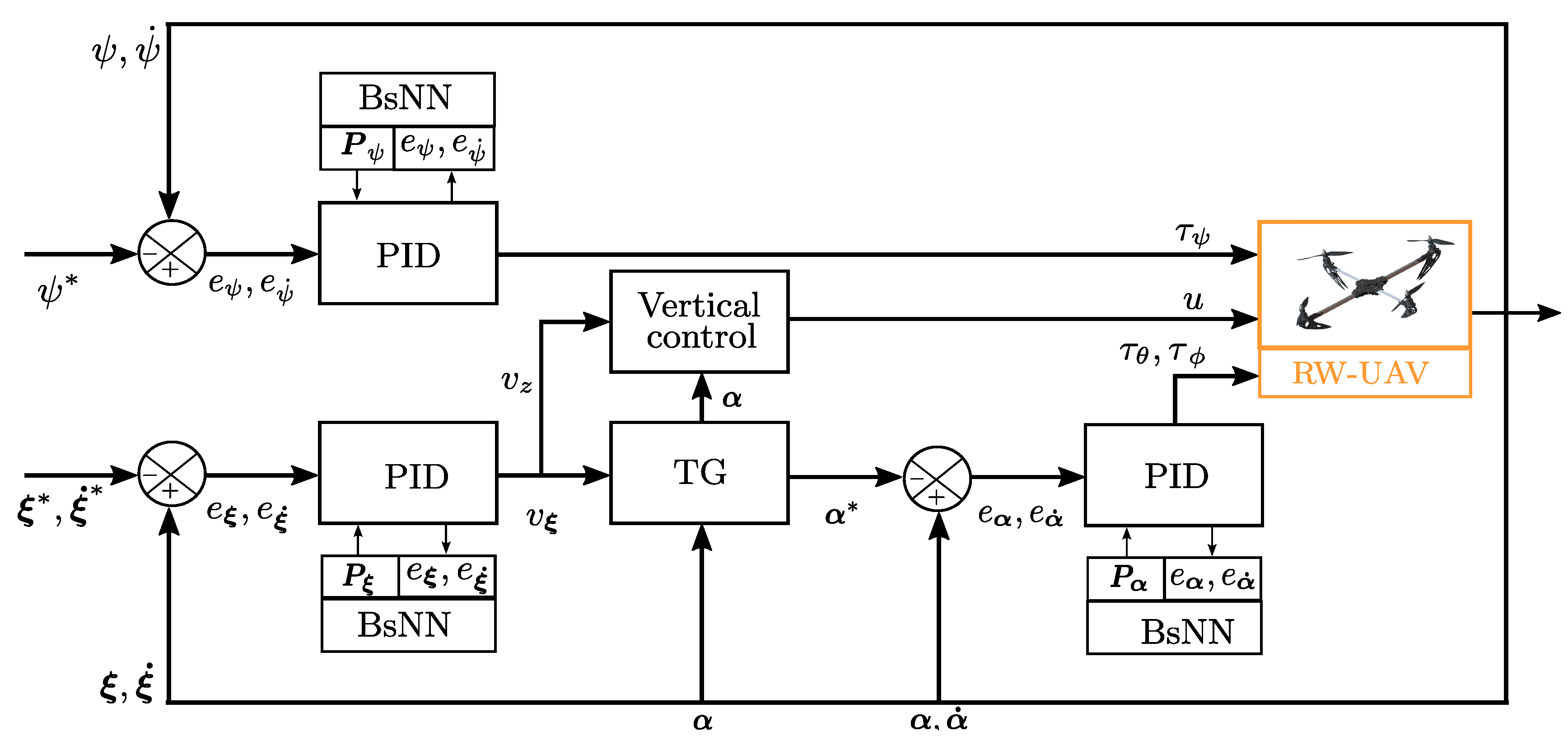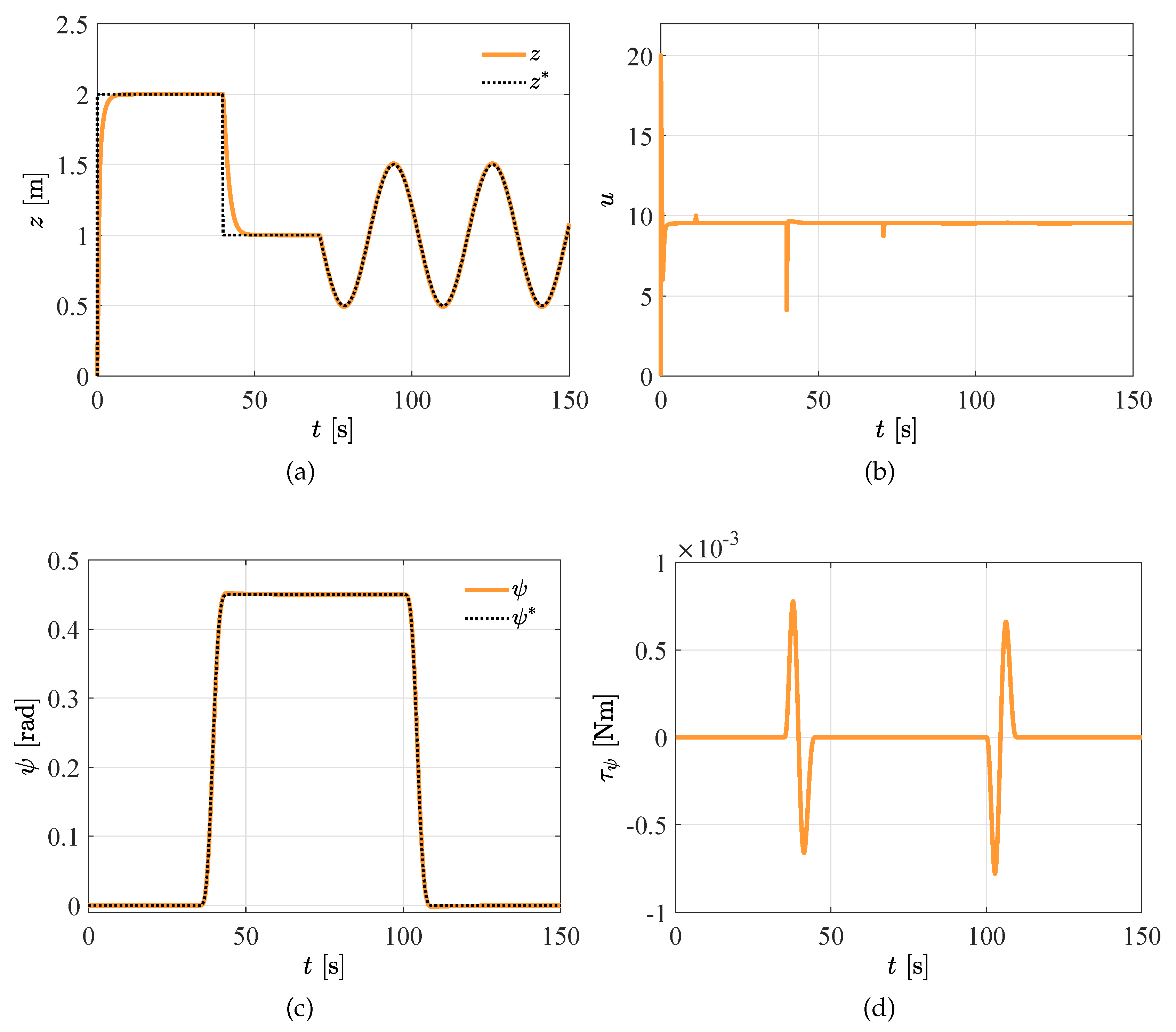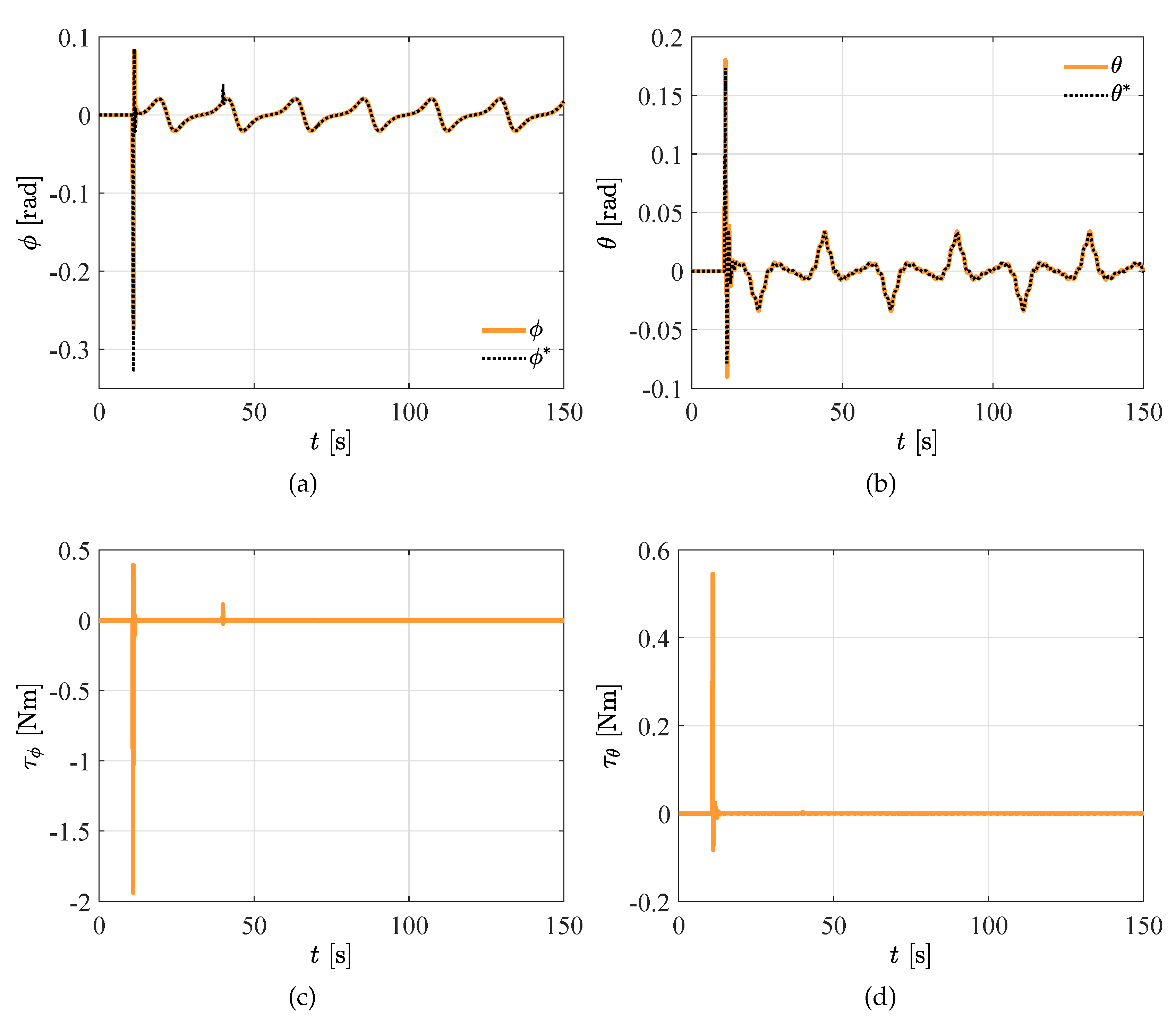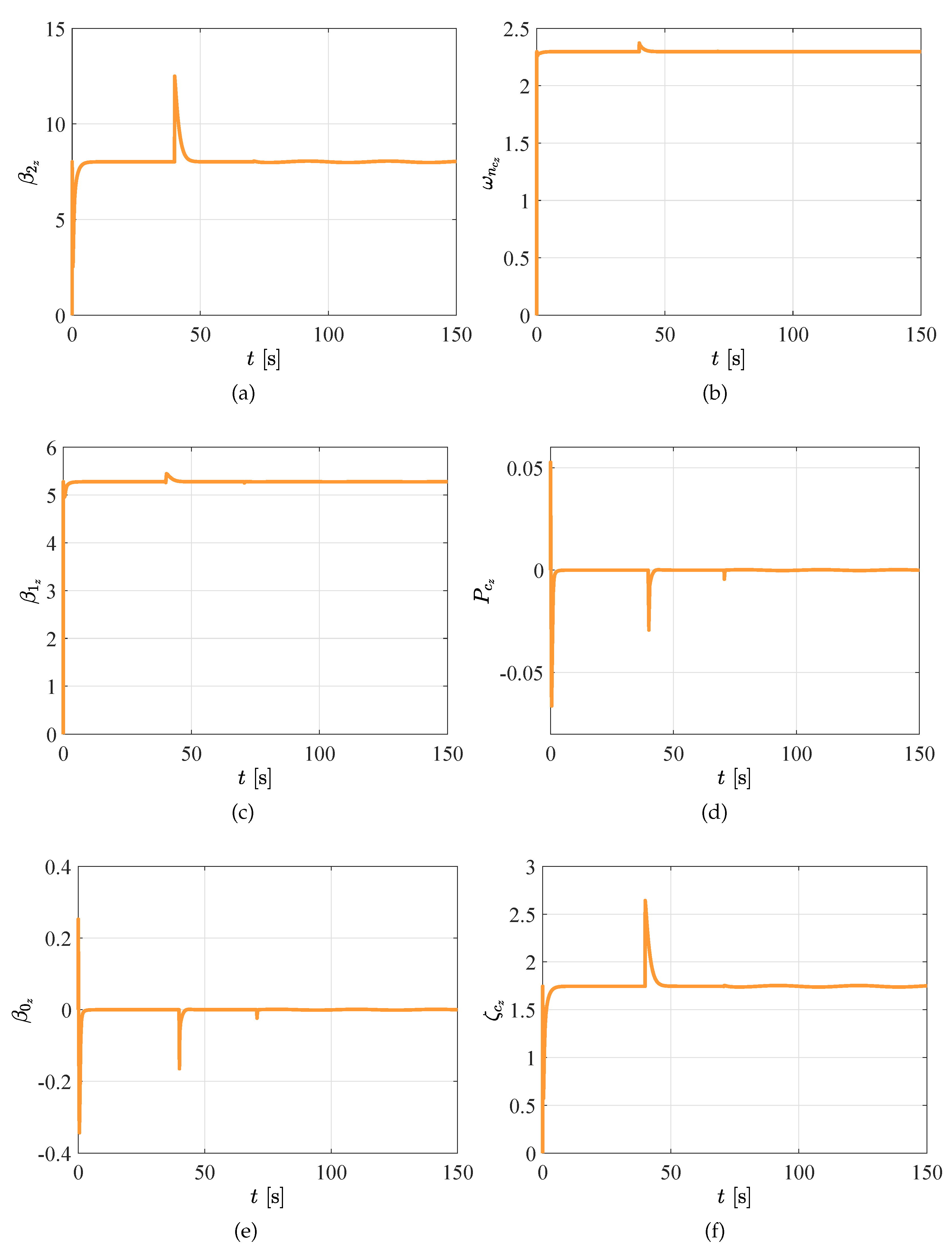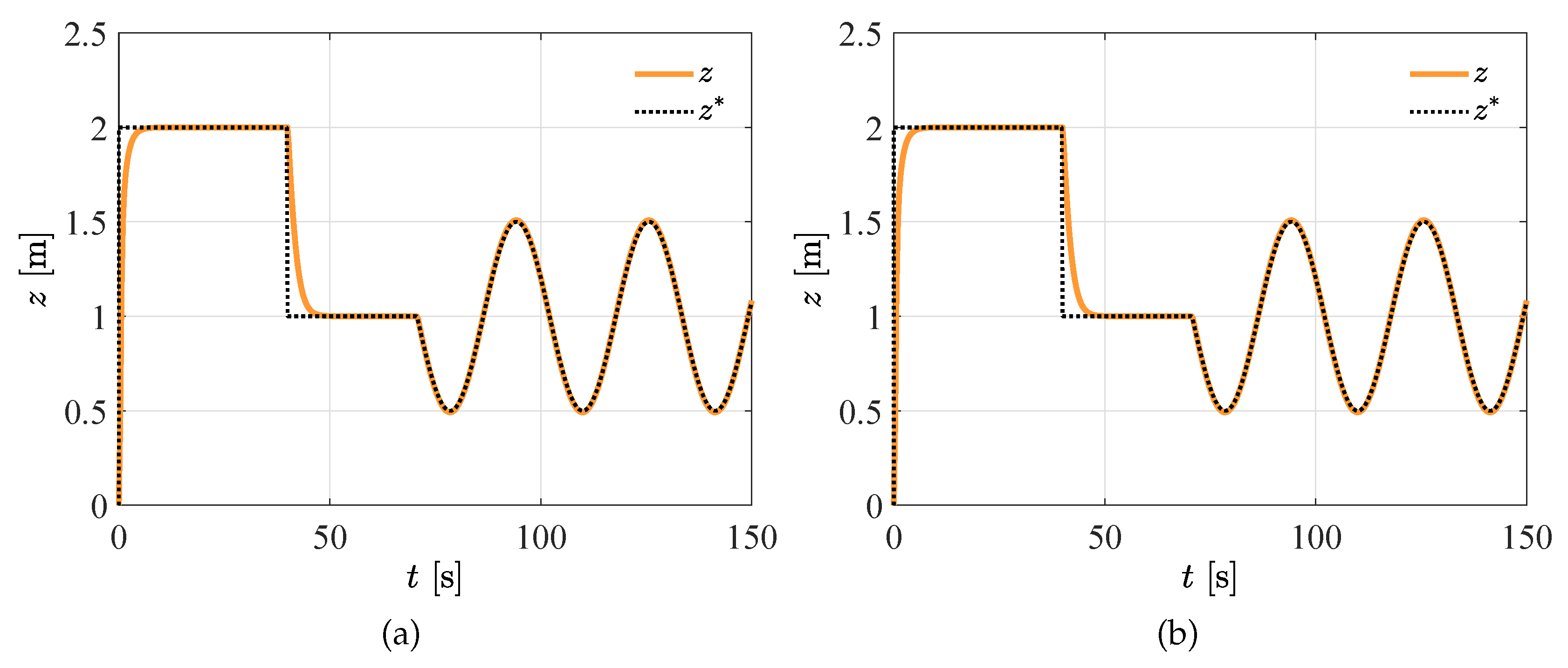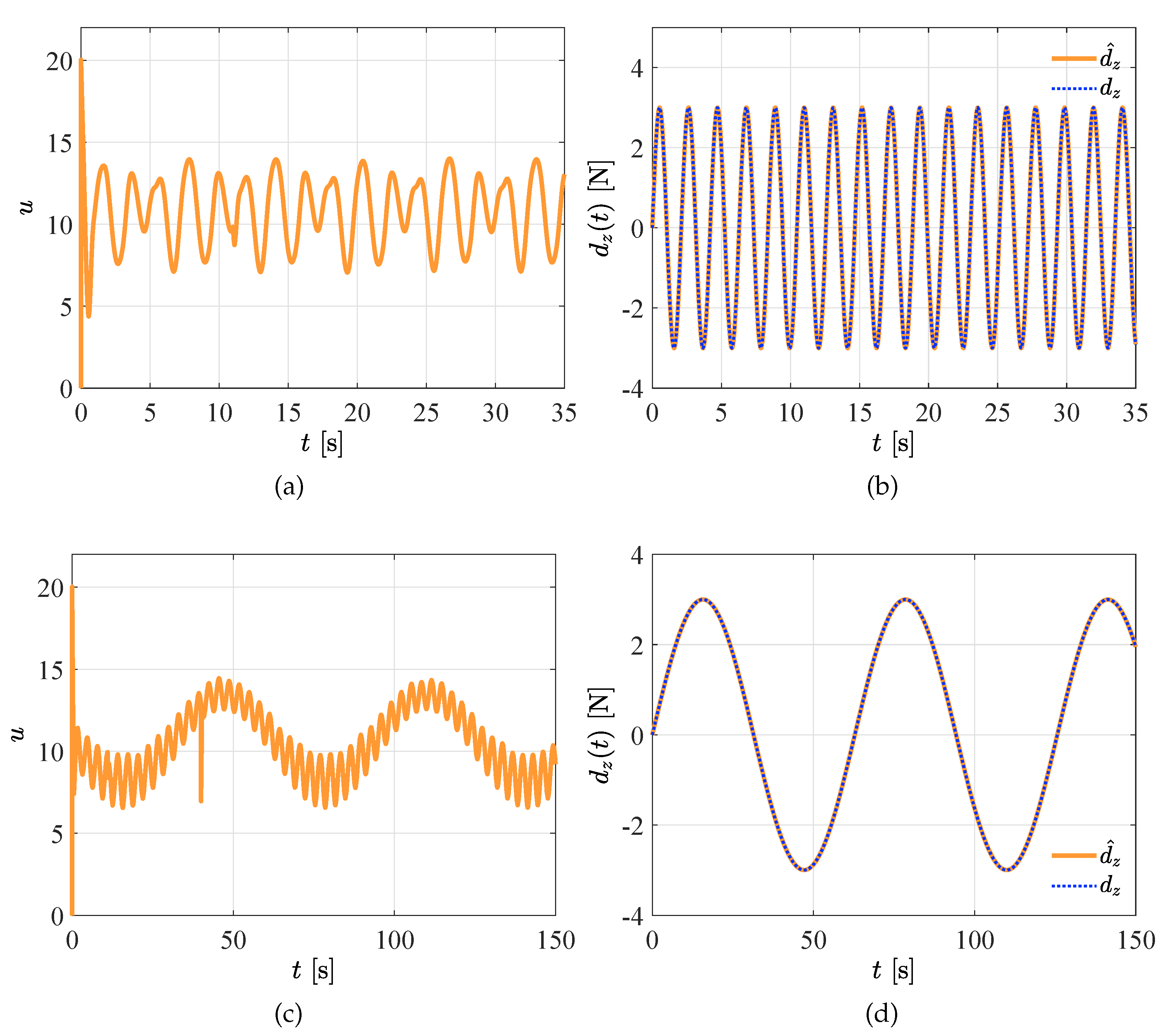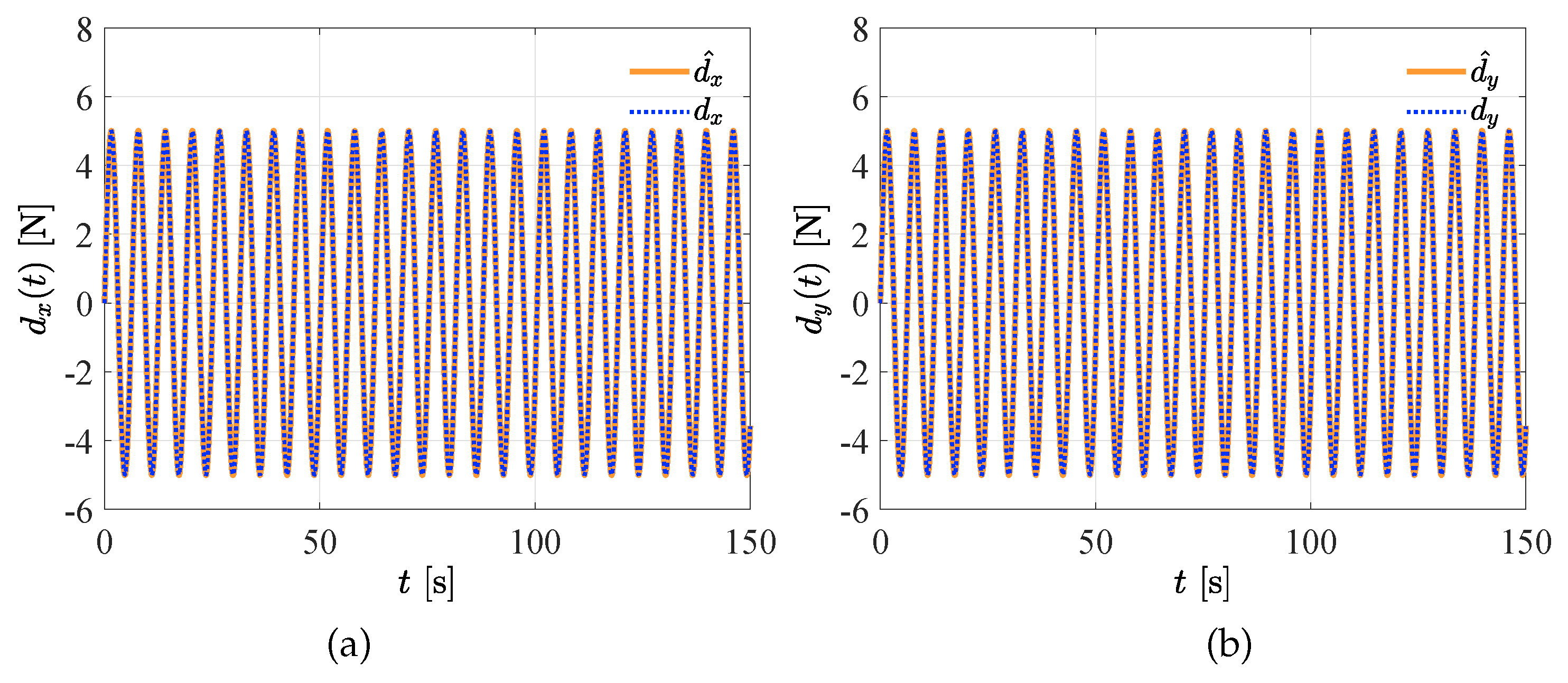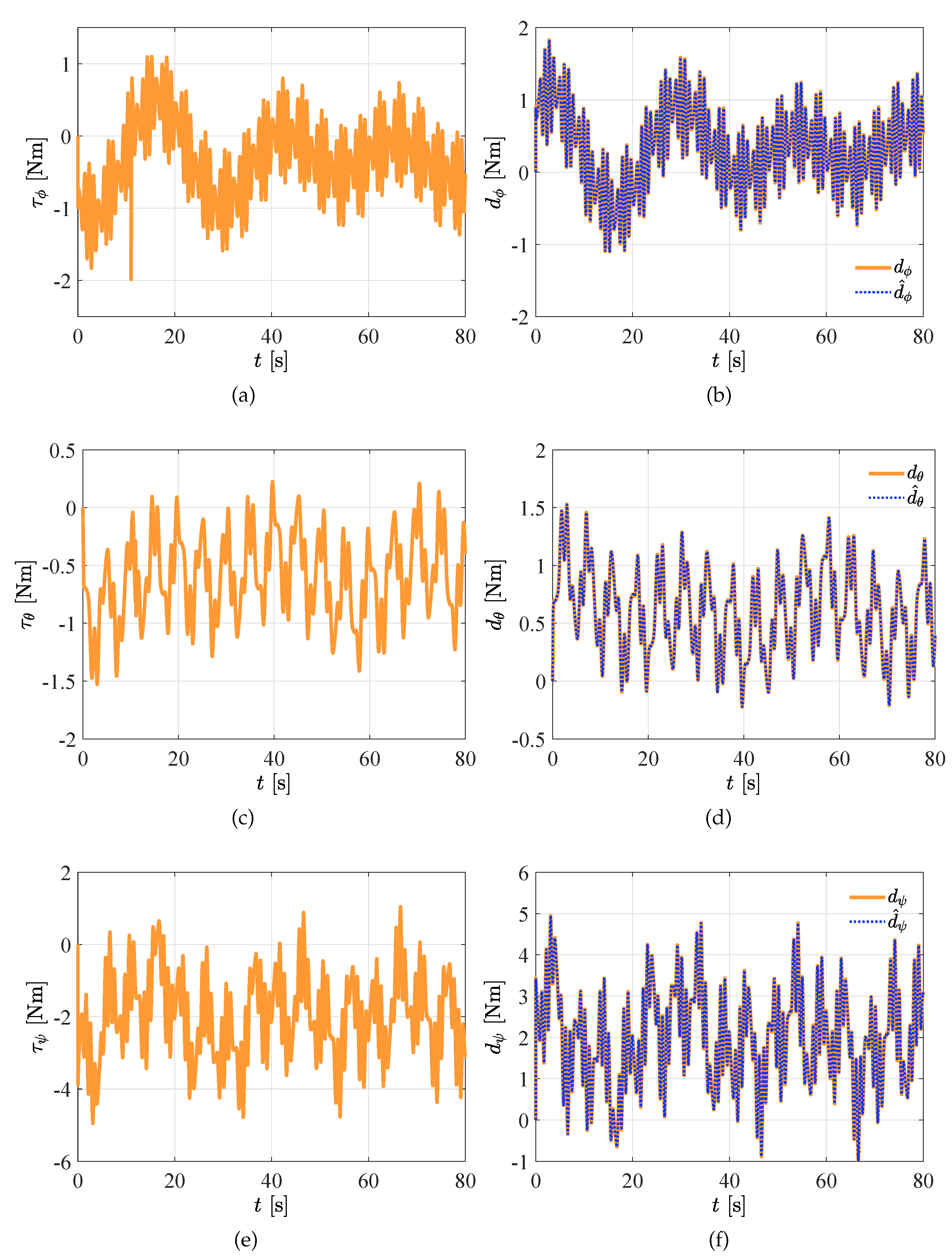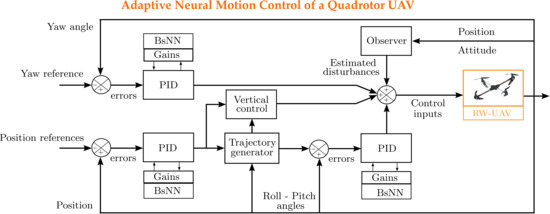1. Introduction
The interest in the study of unmanned aerial vehicles (UAV) has increased in the last years since these aerial machines are able to accomplish several sorts of tasks. Diverse configurations of these vehicles one may encounter in many different applications, e.g., surveillance, monitoring, inspection, mapping, or payload transportation [
1]. The four-rotor helicopter is a rotary-wing unmanned aerial vehicle (RW-UAV) commonly named as quadrotor [
2]. This has been the focus of various technological and scientific research works. This vehicle is an underactuated system, due to it counts with six degrees of freedom and only four independent control inputs; providing this platform the ability of vertical take off and landing (VTOL). This feature allows its safe operation in interiors, unlike other UAV’s such as the fixed wing (FW-UAV) type that need large and wide space extensions for take-off and landing [
3].
During their operation, quadrotors are subject to endogenous and exogenous uncertainties, due to a highly changing medium as a consequence of variable wind speeds, fluctuations in the surrounding humidity and air resistance. Thus, a complex non-linear dynamic behaviour between relevant variables and uncertainty is observed. Taking this into consideration, and in order to perform tasks of trajectory tracking, slow and fast motion, hovering, stable flight and VTOL, the design of robust motion control schemes is necessary.
Different linear and nonlinear control strategies have been proposed in the literature for control of quadrotor helicopters. In [
4], conventional proportional integral derivative controller (PID) and linear quadratic (LQ) controllers are developed for stabilization tasks for a quadrotor in presence of small perturbations. PID control algorithms have been also introduced in [
5]. Here, results show that the proposed controller presents a good performance for flight in controlled environments and a trajectory tracking with relatively slow speed only. In spite of being unable to deal with large disturbances, classical controllers present a compact and functional structure which has allowed their successful implementation in commercial models [
6].
In some works, diverse control strategies composed of conventional and nonlinear robust controllers are introduced to deal efficiently with external disturbances, model uncertainties, internal cross couplings and noisy sensor measurements. The introduced scheme in [
7] consists of a backstepping based PID nonlinear controller to regulate the quadrotor rotational dynamics, the integral of tracking error is considered in the backstepping control design to minimize the steady-state error. The work developed in [
8] deals with the regulation of position for the quadrotor through a robust PID control. Meanwhile, the attitude problem is solved by means of integral backstepping and terminal sliding mode controllers, providing robustness to the control loop against external disturbances.
Furthermore, diverse nonlinear robust controllers have been reported facing the disturbed helicopter dynamics, as is introduced in [
9,
10]. Here, the authors study the response of a quadrotor prototype for tracking trajectories by using backstepping and sliding mode strategies. In the first one, the backstepping control stage allows to compensate the rotational dynamics in presence of bounded perturbations. Nevertheless, sliding mode control introduces high frequencies to the system through the chattering phenomenon. Therefore, in the second proposal, the backstepping and sliding mode controllers are arranged to face the chattering phenomenon and the discontinuous action of control inputs, improving in this way the quadrotor tracking performance when unknown disturbances occur. Additionally, different schemes for enhancing sliding mode control performance have been also introduced in the literature. For example, in [
11] a second order sliding mode controller is proposed for attenuating the switching problem without affecting the quadrotor flight performance. At the same time, in [
12] unmatched perturbations and chattering problem are effectively solved by a block controller combined with the super twisting algorithm.
Besides, in [
13] a nonlinear
controller is introduced for controlling rotational dynamics and a model predictive controller (MPC) for performing tasks of trajectory tracking in the
X and
Y directions, in order to ensure a proper path following. In their study, authors consider external disturbances on the six degrees of freedom as well as parametric uncertainties. Meanwhile, in [
6] robust compensators are proposed providing robustness to nominal PD control synthesis for attitude and position control in order to restrain the effects of uncertainties. Adaptive control has been proved to be powerful to handle parametric uncertainties and obtain asymptotic stability without using high-gain feedback or switching terms [
14]. So, many authors have used adaptive controllers for solving the quadrotor control problem. Authors in [
15] propose an adaptive control scheme with an intelligent observer based on artificial neural networks (ANN). Here, aerodynamic effects have been considered as disturbances. On the other hand, some modern nonlinear algorithms have been proposed as in [
16] where a nonlinear internal model control (NLIMC) is introduced for controlling a quadrotor perturbed by wind gusts. The performance of the control is ensured by fixing a reference model of the tracking error. Meanwhile, in [
17] a framework of Active Disturbance Rejection Control (ADRC) and Embedded Model Control (EMC) is proposed for robust attitude control of a four-rotor helicopter, where an state predictor, a control law, and a model-based reference generator are designed.
One of the main problems of the flight control systems is due to the combination of nonlinear dynamics, modelling uncertainties and parameter variation in characterizing an aircraft and its operating environment [
18]. One fact that should be pointed out is that many uncertainties in control systems are unmeasurable; thus, the disturbance estimation technique represents a very good alternative to actively suppress time-varying disturbances [
19,
20]. Effectiveness and robustness of the ADRC has been proved for a wide range of engineering applications which involve different single input-output (SISO) and and multiple input - output (MIMO) systems (e.g., power converters [
21], electric motor drives [
22], mechanical systems [
23], unmanned aerial vehicles [
24], among others).
Some interesting ADRC based control schemes for the robust motion control of the quadrotor flight, have been reported. The proposed scheme in [
25], implements a linear active disturbance rejection control (LADRC). Here, disturbances are estimated by a Linear Extended State Observer (LESO), and rejected by a PD controller; showing an acceptable control performance in overshoot, rise time and settle time. However, reported results consider weak disturbances only. On the other hand, authors in [
26] propose a linear active disturbance rejection sliding mode control for addressing the system uncertainties and external disturbances, which are estimated by a LESO and afterwards, actively rejected through a sliding mode controller. In that study, slightly disturbed components are injected for altitude and attitude displacements in order to show the proposed controller performance. Meanwhile, even though ADRC control is able to reject the total disturbance, authors in [
27] put all the available process information as an input in the control scheme for improving the disturbance estimation. On the other hand, in [
28] satisfactory results are achieved to stabilize the system with a nonlinear modified version of the ADRC, where an extended state observer (ESO) is proposed for state estimation in order to deal with input delays and filter noisy output measurements of the variables of interest. Recently, the design and develop of modified and enhanced versions of the central ideas of the ADRC has been reported, as in [
29]. Here, researchers propose a robust integral of sign of error (RISE) scheme and a disturbance compensation for the tracking trajectory of a quadrotor UAV. In that work, velocity measurements are unnecessary but the use of a third order ESO is required to achieve a high tracking performance.
In this work a novel robust adaptive neural motion control scheme for quadrotor vehicles is proposed. The presented control design method is based on synthesis of B-spline artificial neural networks (BsNN) and on-line estimation of dynamic disturbances, where an linear extended state observer is implemented to improve the robust control capability to actively suppress significant disturbances affecting the underactuated nonlinear system dynamics.
Efficiency and robustness of the controlled nonlinear dynamic system are significantly improved, since B-spline neural networks have capabilities for efficiently control physical systems by updating their response on-line, considering a simple structure and a small number of basic mathematical operations. Besides, the estimation of lumped disturbances allows to actively compensate it on-line by including in the nominal adaptive controller. In contrast with other controllers proposed in literature, in our scheme it is no necessary a full knowledge of the mathematical model and there is neither high frequency nor high gain behaviour of the control inputs due to the suitably selection of the PID-like controller gains by the B-spline neural networks.
Simulation results are included to verify that the novel control scheme represents a very good alternative to efficiently perform desired motion tracking for quadrotor helicopters. Moreover, simulations results yield that our motion control scheme can efficiently adapt to diverse uncertain operating scenarios even in presence of exogenous disturbances.
2. Dynamic Model
The quadrotor is an under-actuated and MIMO dynamic system with six degrees of freedom and only four control inputs. Moreover, its dynamic behaviour is governed by a set of strongly coupled nonlinear differential equations. A quadrotor is commonly designed to have a rigid body mechanical structure in order to obtain a simplified mathematical model, where two frames of reference are used to describe its dynamic behaviour [
2,
30]. The first inertial coordinate (global) frame reference
with X, Y and Z axes is attached to the earth, and the second (local) one
, with X’, Y’ and Z’ axes fixed to the centre of mass of the quadrotor as depicted in
Figure 1. The suitably balanced mechanical structure has four rotors located symmetrically, which are used to generate the control force and torques represented as
u,
,
and
, respectively. Thus, force and torque controllers should be synthesized to perform on-line and off-line trajectory tracking for translation and rotation motion in the three-dimensional space planned for the quadrotor. The system motion is achieved by increasing or decreasing properly the speed of each rotor. The pair of rotors 1 and 3, spin counter-clockwise and the other in clockwise. Thus, pitching moment (
) is produced by rotors 1 and 3; rolling moment (
) is caused by the difference between forces produced by rotors 2 and 4; and yawing moment (
) is originated when angular velocities of lateral rotors are modified. Meanwhile, the control force
u that allows lifting the body of the quadrotor, includes all the vertical forces produced by each rotor.
The relation between rotor forces (
) and control inputs is given by [
2]
where
l is the distance from the motors to the centre of mass and
stands for the torque induced by each electric motor
.
and
are related to the geometry of the rotors blades by means of the coefficients of thrust and drag. Hence, it is easy to see in Equation (
1) that motion in different directions on the plane can be attained by regulating angular velocities of rotors in order to change the magnitude of the forces
. Therefore, by suitably combining the rolling, pitching and yawing moments, a quadrotor can track different reference trajectories.
Exhaustive studies on the quadrotor mathematical model have been reported in the literature, where both numerical simulations an experimental tests have let to validate mathematical representations for describing the four-rotor helicopter dynamics. Since it is consider generally as a rigid body, representations as Newton-Euler, Euler-Lagrange and their derivations can be used to describe translational and rotational dynamics. Usually, a vector of generalized coordinates
is used to represent the position and orientation of the body respect to the inertial reference frame as follows
where
,
and
are the Euler angles describing the orientation of the system, and
x,
y and
z are the position coordinates of the centre of mass (summarized as attitude vector
and position vector
, respectively) measured with respect to the inertial reference frame
, as shown in
Figure 1. Therefore, for purposes of control design, consider the following experimental validated quadrotor mathematical model [
2,
31,
32], which is a Newton-Euler nonlinear simplified approximation around the hovering condition.
here,
and
represent the main force and torques acting on the quadrotor centre of mass expressed in the body frame. Meantime,
is the velocity vector. The angular velocity vector is
and
is the inertia tensor, both regarding the body frame
. The matrices
and
stand for
skew-symmetric matrix of the
vector [
33] and the orthogonal rotation matrix (which allows to transform orientation between both reference frames,
to
[
34,
35]), respectively. Then, in order to express the equations regarding the inertial fixed frame, let
and
, where
The angular body velocities are related with rate of change of the Euler angles, which represent the quadrotor attitude in the inertial frame, under the next assumption
Thus, by using a standard kinematic transformation [
33]
and assuming that in the zero vicinity the approximation
,
and
is valid, the nonlinear dynamic model of the quadrotor can be resumed as follows
where
m is the total quadrotor mass,
and
are the diagonal elements of the tensor of inertia expressed in the body frame,
g the acceleration constant of gravity,
is the gyroscopic effect resulting from the propeller rotation, with
as the propeller moment of inertia and
as the overall sum of rotors speed. On the other hand,
and
are the exogenous disturbances affecting the translational and rotational dynamics, respectively. Notice, that in spite of this model is a simplified version, rotational dynamics has numerous nonlinear couplings, which means that to solve the control problem it is not an easy task.
4. Numerical Experiments
Several numerical simulations are performed to asses the robustness of the proposed adaptive robust controller. Here, the control scheme should provide an acceptable level of attenuation of the exogenous disturbances for a flying quadrotor which is tracking a planned reference. The outline of the evaluation process is as follows: firstly, a nominal adaptive PID controller is evaluated for the unperturbed helicopter flight. Secondly, harmonic forces are injected to the system in order to visualize the response of the nominal controller. Finally, a scheme of disturbance estimation and compensation is attached to the nominal adaptive control law for improving their robustness capabilities.
The planned reference trajectories were selected in such a way a
lemniscate path shape [
42] is described on the horizontal X-Y plane. So, the individual dynamic references for
x and
y positions are given by the parametric equations and their derivatives depicted in
Table 1.
A value of
m is adopted for the distance to the origin to one of the
lemniscate focus. Meanwhile, in order to asses the robustness and adaptability of the system to track a desire time-variable position
, the mixture of step and variable profiles presented in
Table 2 is used as the planned reference. On the other hand, a Bézier interpolation polynomial was implemented to obtain a smooth transient between initial and the desired yaw angle
, which is given by
where:
s,
s, for
;
s,
s, for
s; and
, for
s.
During indoors operations quadrotors are able to accomplish several kind of tasks without problems, but it is not the same for uncontrolled environments, where the surrounding medium is constantly changing, and different forces are induced as consequence of wind. So, one the main issues to be solved by the automatic control algorithms is the adaptation among different operational conditions. Thus, in our study some disturbing forces are used in order to simulate an probable outdoors uncontrolled medium.
4.1. Nominal Adaptive Control Performance
The performance of the introduced adaptive controller is portrayed in
Figure 4, where an efficient vertical trajectory tracking and a proper yaw position regulation is achieved. Moreover, it can be verified that in spite of a change in the sort of reference profiles, the controller guarantees close-loop stability while an acceptable tracking is performed.
Similarly, a properly computation of the dynamics gains is corroborated meanwhile the high-gain feedback effect is minimized, which is one of the most relevant features of the adaptive control nature. Notice, from Equation (
7), that the main thrust force influences also on the motion in
X and
Y directions, meanwhile is actively compensating the gravity force effects. Therefore, special attention needs to be taken during the vertical motion control design process. Furthermore, from
Figure 4 it is observed the smoothly transients of the position regulation of the yaw angle by using the polynomial (
24), such that the computed yawing torque is sufficiently soft and free of high frequency oscillations. On the other hand,
Figure 5 shows that the proposed adaptive control configuration allows the system performing an effective tracking of the pitch and roll angles (computed on-line by expression (
10)) in spite of the fact that derivatives
and
are not included in the control scheme. Also, the control input torques
and
presents an reachable magnitude, which can be transformed as forces by means of an inverse relation of the expression introduced in (
1).
As a result of suitable feedback control design, the helicopter is able to follow the predefined
lemniscate reference path within the two dimensional X-Y plane,
Figure 6, as a consequence of the properly trajectory tracking shown in
Figure 7.
During the experiment, it is evident that by the action of the introduced adaptive PID controllers, both fully actuated and underactuated dynamics are properly controlled.
Figure 7 depicts the close-loop response of the system underactuated dynamics, where the trajectory tracking issue is properly solved by the suitably action of the introduced virtual controllers. As aforementioned, by the regulation of the roll and pitch dynamics, it is possible to ensure the desire motion on the horizontal plane. So it can be conclude that regulation of the angular dynamics plays a fundamental role in control motion, as well as a correct selection of the expression (
9) which relates the calculus of the reference angles, whose dynamics are fully actuated, with the underactuated motion.
Different operational conditions where considered for the BsNN training process, where the system is carried from an initial condition to a desired point [
37]. Notice it is complicated to know the derivatives of the on-line computed references, since
and
are functions dependants of the dynamic controllers
and
, of the mass, the constant of gravity, and the actual feedback values
and
. Nevertheless, the adaptive structure allows to compensate adequately this absent of information.
For simplicity of results presentation, in
Figure 8 it is presented only the dynamic gain values for the regulation of
z position. Here, it is observed the dynamic behaviour of the control parameters which are intelligent adjusted by the use of the neural networks. The plot also shows that, in specific small time windows, the values of the control gains turns briefly to negative values, which in a fixed gain control scheme could be lead to a system unstable condition.
From figures, it is evident the effectiveness of the introduced adaptive control scheme (
Figure 3) to deal with the trajectory tracking problem of a quadrotor UAV. In the study different sorts of references profiles where assigned for the fully actuated vertical motion, as well as for underactuated motion above the horizontal plane. Besides, due to the action of the adaptive gains scheme, the effects of feedback high-gain are suitably minimized, which means that the actuators will be not saturated.
Additionally, in the next section, some disturbance forces are included in order to asses the robustness of the proposed adaptive control scheme while the quadrotor is performing tracking tasks.
4.2. Adaptive Control Performance against Disturbances
For the sake of simplicity in the results presentation, only results from vertical motion are included. Nevertheless, the introduced control schemes were properly validated by several simulations for the other translational and rotational motions. Therefore, in order to simulate the possibly effects of the wind on the flying quadrotor within an uncontrolled environment (crosswinds and gusts), two different disturbance signals are injected to the system: with for both case studies, and and for the first and the second test, respectively. Besides, harmonic forces perturbing the roll and pitch dynamics are included as for .
In
Figure 9 it is observed the response of the system subjected to two different disturbances. Here, the adaptive controller tries to compensate the undesired induced oscillations while tracking tasks are executed. As it is illustrated in the pictures, in spite of that the nominal adaptive control allows the quadrotor tracking the planned references, in both cases undesired motion oscillations are present. Moreover, the respective computed control inputs are not smooth. Keep in mind that due to the BsNN’s work as iterative algorithms it is possibly that in specific sceneries, with particular operational conditions, they could act as filters in presence of relative high frequency signals, which will be a discussion topic in future studies.
Notice, that the magnitude and frequency of the injected disturbance signals have significant effects on the dynamic response of the system. It is important to highlight that even in the presence of significant disturbances the control scheme is able to keep the quadrotor near of the desire reference position. Nevertheless, it is desirable that undesired oscillating motions not to be present in the system response.
It is evident that the satisfactory results achieved for the unperturbed case are quite different for both disturbed case of studies. Thus, it is necessary to consider the use of the observer mechanism for disturbance estimation, and in this fashion, take advantage of the features of both control structures.
4.3. Robust Adaptive Control Performance against Disturbances
Now, consider the following control law for the auxiliary vertical motion controller
where
is the disturbance estimated by the extended observer (
22). So, by substituting the Equation (
25) in the disturbed version of (
12) for
z variable
then,
so, by assuming that
, then without loss of generality, the Equation (
14) is true, and the nominal controller is then responsible of tracking and regulation tasks. The observer gains are selected as
,
,
, with
for translational and
for rotational dynamics, respectively.
Then, as aforementioned (and previously demonstrated), the nominal optimal controller is able to perform a very good tracking and regulation.
Figure 10 depicts the reference tracking for both case studies, where the proposed robust adaptive PID controller is implemented. Here, a satisfactory performance of the control scheme is observed, where even in the presence of the disturbances, the efficiency of the control action is not affected, which guarantee close-loop stability.
The main force control input
u for each case study is portrayed in
Figure 11, where is evident the effects of the injected compensation for actively reject the estimated disturbance
. On the other hand, it is observed that the selected observer gains allows to tracking the real disturbance by the estimation. Notice, the estimated variables can be used in the controller design, or such as complementary information in the filtering stage for data collected by sensors. In the pictures related with the case study 1 in
Figure 11, the time scale has been modified with purposes of improve the visualization of the yielded results. Moreover, it is shown that in spite of the oscillations present in the control signal, the motion is free from undesired oscillations.
Finally, in
Figure 12 it is observed the effectiveness of the introduced control strategy, where both the unperturbed and perturbed responses for the underactuated motion are depicted. Here, harmonic forces perturbing the horizontal displacements (lateral and longitudinal) are included as
for
,
Figure 13.
Moreover, it is appreciated the control robustness to face undesired harmonic effects induced by endogenous perturbations, where only a slight deviation from the reference trajectory is observed at . Also, despite the derivatives of the on-line computed angular references are not included in the control scheme, the adaptation capabilities provided by the BsNN control allow a proper tracking of the angular dynamic references and , ensuring at the same time the planned motion on the horizontal plane. It is worth to note that the study of the design and implementation of this kind of controllers can be extended to another aerial vehicles as the fixed wing UAV.
4.4. Dynamic Response in Presence of Turbulent Wind Field
In this section the Dryden wind gust model presented in [
24] is introduced to the system in order to verify the quadrotor behaviour by using the proposed controller. Here, it is assumed that the disturbance caused by wind field is proportional to the wind speed, and is defined as a set of sinusoidal excitations given by
where
is a description of the wind disturbance in
,
or
channels in a specific instant of time, meanwhile
and
are randomly selected frequencies and phase shifts, respectively;
n is the number of sinusoids,
is the amplitude, and
is a static term for wind disturbance. Besides, the disturbance torque caused by the wind field is proportional to the wind speed [
24]. Thus, the model (
28) can be used as torque disturbances
,
and
in (
7), where the particular values considering
for
, are summarized in
Table 3.
Results portrayed in
Figure 14 and
Figure 15 show the performance of the system while facing the disturbance torques described in
Table 3. Here, the robustness capabilities of the proposed scheme allows the quadrotor following the reference trajectories.
In addition, for the sake of simplicity in the results presentation, only 80 seconds of the full time line are presented. From figures we conclude that the introduced controller is a very good alternative for deal with disturbance rejection problem while trajectory tracking tasks are perform by a quadrotor helicopter.
